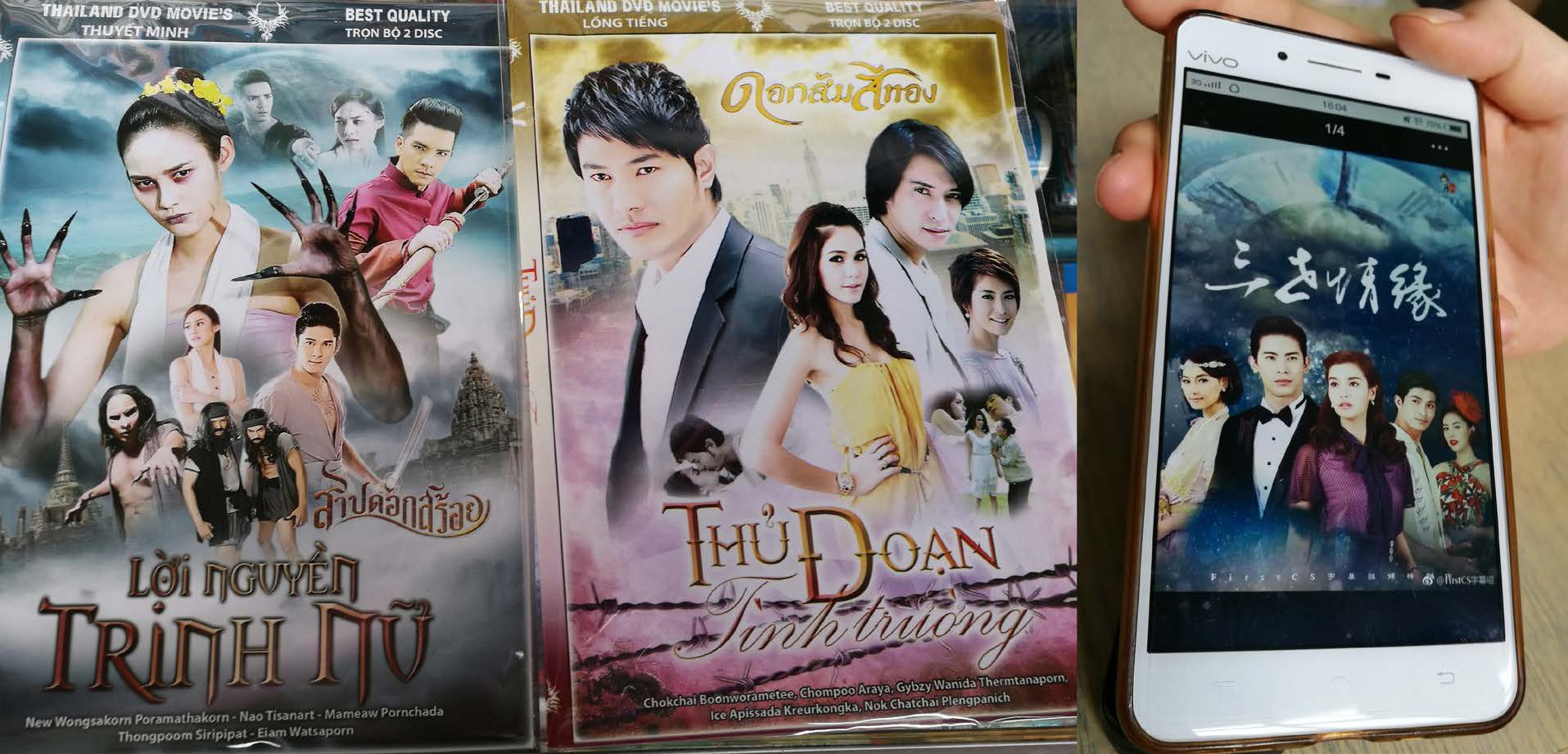Thai television dramas, which have been a staple of the nation's TV landscape for over four decades, tend to be what Thai people call "lakorn nam nao" (polluted soaps). The namnao or polluted characteristic lies in their portrayal of unreal life, presenting a visual grammar of lavish and luxurious settings, over-exaggerated acting, and melodramatic plots. In the late 2000s, Thai television dramas gradually started to gain popularity in Asia. Beginning in 2003, Thai dramas entered Chinese television channels, followed by the success of many drama series in the following years. For example, Battle of Angels, broadcast on Anhui Satellite TV in 2009, achieved the tenth highest audience rating of all programs in the first week it was released and was re-run four times between 2009-10 (Danaithan 2012). Following the success in China's television market, the past decade saw the outward flows of Thai television dramas expanded to Vietnam, Indonesia, Taiwan, Singapore, Malaysia, and the Philippines. Besides being exported for telecast, the phenomenon of subtitles created by fans in many countries has also made Thai dramas more widely accessible.
The reasons for the new outward flow of Thai television dramas in the region vary. As many scholars have argued, broadcasters in Asia now operate under the assumption of greater market fragmentation and the need to cater to niche audiences, as they exhibit less consumption loyalty (Lim 2008). Growing economies on the receiving end also contribute greatly to the increasing outward flows of Thai dramas. In Vietnam, for example, the growing cable television market has fostered a high demand for television content. Likewise, the government’s privatization of television channels (in Myanmar), the growth of cable television networks (in Cambodia), and the advance of mobile technology, combined with the ebb of Korean dramas, have contributed to the increased growth in Thai television dramas in these countries’ broadcasting scenes. More importantly, the notion of cultural proximity contributes greatly to the success of Thai dramas in these neighboring countries. As for China, nationalistic fear over dominant Korean popular culture has led the Chinese censorship board to limit Korean television imports. This in turn gave way to more Thai imports (Danaithan 2012). In addition, the higher quality of Thai television dramas over the past decade, and the low price of Thai drama exports, have enabled them to compete with the more expensive Korean television dramas. Danaithan (ibid.) points out that between 2009–11, some satellite televisions in China broadcasted about 8–10 Thai television dramas series per year.
This short essay focuses particularly on China, exploring the aspects of consumption among Chinese audience who watch Thai television dramas through streaming sites and the fan-subtitle groups who translated Thai dramas into Chinese language. After making its successful entry into China’s television market in the late 2000s, the past decade has seen the ebb and flow of Thai television dramas in China. The tightening state controls on broadcasting foreign media, including limiting the number of foreign imports, tight censorship, and viewers being able to identify clichéd elements in Thai dramas, have led to a decline in the popularity of Thai dramas in China (Chan 2012). While the first wave which began with Battle of Angels waned around 2011, Chan has argued that Chinese interest in Thai television dramas was renewed through Chinese streaming sites. This recent decade has seen the phenomenon of enthusiastic fans who obtain foreign cultural products, translate the text, then release subtitles for viewing, without asking for permission from the copyright holders. Recently, there are more than 10 subtitling groups of Thai dramas on Chinese videosharing websites. Of these, the most popular one is Tianfutaiju whose translation focuses on Thai boys’ love series, a point I return to later.
It should be noted that the present generation of Chinese audiences that watch Thai television dramas on the internet today differ from those of the previous decade who consumed Thai dramas from television. While audiences of the previous decade tended to be housewives who may passively receive what media industry offered to them, the audience of the new generation are millennials who are young, relatively well-educated and live in urban areas. They do not passively watch whatever has been broadcasted but constantly search for global media content not available at home. The content which these different generations prefer also differs. The older generation tends to like Thai television dramas whose stories revolved around family relationships with melodramatic plot twists and over exaggerated acting while the younger generation prefers teen dramas whose stories are more related to their everyday life. However, it is not uncommon to find young audience who like the melodramatic stories of the Thai dramas. The younger audience are also drawn to Thai television dramas for the beauty and attractiveness of Thai actors and actresses who tend to be of mixed races.

Fig.1 Thai TV dramas that been translated into Vietnamese language and sold as DVDs.
Fig.2 Chinese fan showing a screenshot of how she watches Thai TV dramas from the fansub version on their phone.
One of the most popular genres of Thai television dramas among the new generation of Chinese audience is “boys’ love” series. Boys’ love (BL) has typically been identified with Japanese manga whose stories portray two young men as the focus of a love interest. Most BL fans are heterosexual women, though it is not uncommon for BL to draw gay men or bisexual audience. Japanese BL manga became popular in Thailand around the beginning of the 2000s. Following the popularity of Japanese BL manga, Thai BL literature in the forms of short stories or novels has been written and shared both online and offline. Until recently, television companies began to pick up this trend by producing BL television series. Fostered by a community of enthusiastic fans who work to provide subtitles of BL content in many different language communities, BL series from Thailand have increasingly become popular throughout Asia, particularly in Vietnam, Indonesia, and China. As BL is considered illegal in China for it poses a challenge to heterosexual hegemony, BL series from Thailand have become the main channel for young audience starved of content which has been banned at home.
While internet provides a virtual space for a variety of youthful interest groups in China, the control over what citizen can see on the website has always been exercised by the Chinese state. The latest development happened in July 2017 when the State Press and Publication Administration of Radio, Film, and Television (SARFT) ordered the removal of foreign movies and TV shows from the two most popular video-sharing websites, Bilibili and AcFun. Bilibili is a hugely popular site, originating as a video-sharing site for Japanese anime but gradually became home to all kinds of TV shows. Featuring more youthful content, Bilibili and AcFun have looser restrictions on the content uploaded and shared by users. They have also helped foster a community of Chinese fansubbers who voluntarily translated and subtitled most overseas content. These websites have thus attracted more fans than official websites such as Youku, Tudou, Sohu, and iQiyi. Bilibili also offers features that tend to appeal to a younger audience, such as a “bullet-curtain” mechanism to allow realtime user comments to scroll across the screen (He 2017). After the sudden ban, Thai dramas, along with Korean series, Japanese anime, and American TV shows, were pulled from websites. Thai drama fans expressed their disappointment: a vast collection of Thai dramas were wiped out from the websites and the most famous fan-subtitle group, Tianfutaiju which solely translated boys’ love series from Thailand, also decided to stop subtitling. Some fans were devastated that “without Thai dramas, without Tianfutaiju, what would life be like?”

Fig.3 2Moons the Series is one of Thai BL series which has become popular throughout Asia.
The recent ban reportedly came for two reasons. Some maintain that the ban was part of official efforts to tackle piracy (ibid.). Recently, many official websites such as Youku, Tudou, Sohu, and iQiyi started to obtain copyright for online foreign movies and TV shows. This may be the reason as to why the Chinese government had to act upon those that violated copyright claims. The second reason has to do with censorship. The absence of domestic copyright means those videos shared in Bilibili and AcFun did not pass the government’s content censorship. Right before the removal of foreign content in these two websites, in June 2017, the Chinese government issued new guidelines for online broadcasting, prohibiting unpatriotic and vulgar content. The latter specifically refers to “abnormal sexual behaviors” (Yin 2017) which include homosexuality, adultery, onenight stands, prostitution, sexual violence, or kissing and bathing scenes. One of the fansubbers of Thai dramas lamented that “from now on, we will have nothing to watch but war movies as everything else is banned.” As boys’ love series were the most popular genre of Thai dramas on Bilibili, they became the main target of the ban.
The recent disappearance of foreign media content on these two video-sharing sites signifies the continuing struggle over what citizens can see on the websites. In China, as well as elsewhere, technology is changing rapidly, state and businesses also quickly respond to the transforming conditions. China’s ban on the amateur creation by fan communities begs the question: when the state and businesses are in alliance, can and will netizens, with the help of technology, find ways to escape control?
References
- Chan, Brenda. 2012. Social Media and the Rise of Thai Television Dramas in China. Paper presented at the Conference on Social Media and Cross-border Cultural Transmissions: Technologies, Policies and Industries, June 21–22, 2012, Asia Research Institute, Singapore.
- Danaithan Phongpatcharathornthep. 2012. A Study of Chinese Audience’s Consumption Taste towards Thai Television Dramas and Thai Films. Chiang Mai: Thai Universities for Healthy Public Policy, Chiang Mai University. (in Thai)
- He, Laura. 2017. China’s Ban on Foreign Content on Bilibili, AcFun is Not about Piracy. South China Morning Post, July 17. http://www.scmp.com/business/companies/article/2102948/chinas-ban-foreign-content-bilibili-acfun-notabout-piracy (accessed on August 28, 2017).
- Lim, Tania. 2008. Renting East Asian Popular Culture for Local Television: Regional Networks of Cultural Production. In East Asian Pop Culture: Analysing the Korean Wave, edited by Chua Beng Huat and Koichi Iwabuchi, pp. 33–52. Hong Kong: Hong Kong University Press.
- Yin, Yejun. 2017. Chinese Video Site Bilibili Takes Foreign Programming Off line.
http://ww w.sixthtone.com/news/1000511/chinese-video-site-bilibili-takes-foreign-programming-offline (accessed on August 28, 2017).
